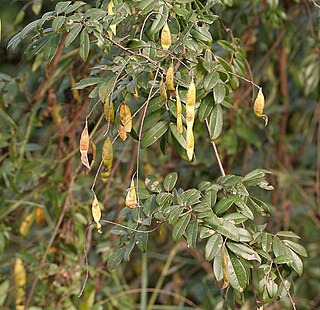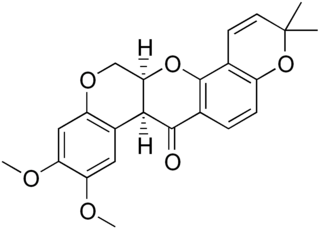
Kava or kava kava is a crop of the Pacific Islands. The name kava is from Tongan and Marquesan, meaning 'bitter'; other names for kava include ʻawa (Hawaiʻi), ʻava (Samoa), yaqona or yagona (Fiji), sakau (Pohnpei), seka (Kosrae), and malok or malogu. Kava is consumed for its sedating effects throughout the Pacific Ocean cultures of Polynesia, including Hawaii and Vanuatu, Melanesia, some parts of Micronesia, such as Pohnpei and Kosrae, and the Philippines.

Insecticides are pesticides used to kill insects. They include ovicides and larvicides used against insect eggs and larvae, respectively. Acaricides, which kill mites and ticks, are not strictly insecticides, but are usually classified together with insecticides. The major use of Insecticides is agriculture, but they are also used in home and garden, industrial buildings, vector control and control of insect parasites of animals and humans. Insecticides are claimed to be a major factor behind the increase in the 20th-century's agricultural productivity. Nearly all insecticides have the potential to significantly alter ecosystems; many are toxic to humans and/or animals; some become concentrated as they spread along the food chain.
Pyrethrum was a genus of several Old World plants now classified in either Chrysanthemum or Tanacetum which are cultivated as ornamentals for their showy flower heads. Pyrethrum continues to be used as a common name for plants formerly included in the genus Pyrethrum. Pyrethrum is also the name of a natural insecticide made from the dried flower heads of Chrysanthemum cinerariifolium and Chrysanthemum coccineum. The insecticidal compounds present in these species are pyrethrins.

The pyrethrins are a class of organic compounds normally derived from Chrysanthemum cinerariifolium that have potent insecticidal activity by targeting the nervous systems of insects. Pyrethrin naturally occurs in chrysanthemum flowers and is often considered an organic insecticide when it is not combined with piperonyl butoxide or other synthetic adjuvants. Their insecticidal and insect-repellent properties have been known and used for thousands of years.

Rotenone is an odorless, colorless, crystalline isoflavone used as a broad-spectrum insecticide, piscicide, and pesticide. It occurs naturally in the seeds and stems of several plants, such as the jicama vine, and in the roots of several other members of the Fabaceae. It was the first-described member of the family of chemical compounds known as rotenoids.
Saponins, also selectively referred to as triterpene glycosides, are bitter-tasting usually toxic plant-derived organic chemicals that have a foamy quality when agitated in water. They are widely distributed but found particularly in soapwort, a flowering plant, the soapbark tree and soybeans. They are used in soaps, medicines, fire extinguishers, as dietary supplements, for synthesis of steroids, and in carbonated beverages. Saponins are both water and fat soluble, which gives them their useful soap properties. Some examples of these chemicals are glycyrrhizin and quillaia, a bark extract used in beverages.

Taro is a root vegetable. It is the most widely cultivated species of several plants in the family Araceae that are used as vegetables for their corms, leaves, stems and petioles. Taro corms are a food staple in African, Oceanic, East Asian, Southeast Asian and South Asian cultures. Taro is believed to be one of the earliest cultivated plants.

The raspberry beetle is a species of beetle in the fruitworm family Byturidae. It is a major pest that is widespread in north-central Europe, affecting raspberry, blackberry and loganberry plants.

Derris is genus of leguminous plants. It contains 65 species, which range from eastern Africa to the Indian subcontinent, Southeast Asia, New Guinea, northern Australia, and the southwest Pacific islands. The roots of D. elliptica contain rotenone, a strong insecticide and fish poison.
Deguelia utilis, syn. Lonchocarpus utilis is a species of shrub in the family Fabaceae. It is native to the tropical forests of Peru, as well as of Brazil and Guyana, growing from 100–1,800 m (330–5,910 ft) above sea level.
Lonchocarpus urucu, or barbasco, is plant in the family Fabaceae. It is native to the tropical forests of Peru, as well as of Brazil and Guyana, growing from 100–1,800 metres (330–5,910 ft) above sea level. It was also recorded in Venezuela.

Deguelin is a derivative of rotenone. Both are compounds classified as rotenoids of the flavonoid family and are naturally occurring insecticides. They can be produced by extraction from several plant species belonging to three genera of the legume family, Fabaceae: Lonchocarpus, Derris, or Tephrosia.

Lonchocarpus is a plant genus in the legume family (Fabaceae). It includes 166 species native to the tropical Americas, tropical Africa, and Madasgascar. The species are called lancepods due to their fruit resembling an ornate lance tip or a few beads on a string.

The environmental effects of pesticides describe the broad series of consequences of using pesticides. The unintended consequences of pesticides is one of the main drivers of the negative impact of modern industrial agriculture on the environment. Pesticides, because they are toxic chemicals meant to kill pest species, can affect non-target species, such as plants, animals and humans. Over 98% of sprayed insecticides and 95% of herbicides reach a destination other than their target species, because they are sprayed or spread across entire agricultural fields. Other agrochemicals, such as fertilizers, can also have negative effects on the environment.
Fish toxins or fish stupefying plants have historically been used by many hunter gatherer cultures to stun fish, so they become easy to collect by hand. Some of these toxins paralyse fish, which can then be easily collected. The process of documenting many fish toxins and their use is ongoing, with interest in potential uses from medicine, agriculture, and industry.

Tephrosia virginiana, also known as goat-rue, goat's rue, catgut, rabbit pea, Virginia tephrosia, hoary pea, and devil's shoestring is a perennial dicot in family Fabaceae. The plant is native to central and eastern North America.

Etofenprox is a pyrethroid derivative which is used as an insecticide. Mitsui Chemicals Agro Inc. is the main manufacturer of the chemical. It is also used as an ingredient in flea medication for cats and dogs.

Derris taiwaniana is a perennial climbing shrub belonging to the genus Derris. It is known by several synonyms, including Millettia pachycarpa and M. taiwaniana. It is widely used in traditional practices, such as for poisoning fish, agricultural pesticide, blood tonic, and treatments of cancer and infertility. The bark fiber is used for making strong ropes.

Derris trifoliata is a plant species in the genus Derris of the family Fabaceae. It common in India and in various Indian languages it is known as Angaar valli in Sanskrit; Karanjvel in Marathi; Firta in Konkani; Tigekranugu, Nauatige and Chirathelathige in Telugu; Ketia and Swanlata in Oria; Kammattivalli and Ponumvalli in Malayalam; Kaliya lata or Kalilata and Panlata in Bengali; Panlata also in Hindi. It is also common in various parts of South East Asia with names eg Filipino ; Indonesian ; Malay ; Thai ; Vietnamese etc.

Antifeedants are organic compounds produced by plants to repel herbivores through distaste or toxicity. These chemical compounds are typically classified as secondary metabolites in that they are not essential for the metabolism of the plant, but instead confer longevity. Antifeedants exhibit a wide range of activities and chemical structures as biopesticides. Examples include rosin, which inhibits attack on trees, and many alkaloids, which are highly toxic to specific insect species, such as quassinoids against the diamondback moth. Samadera indica also has quassinoids used for insect antifeedant uses.















